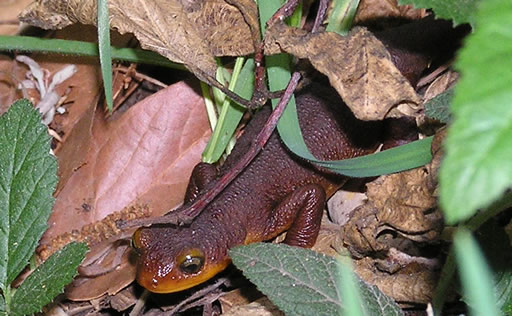Everyone associates the poison or “dart” frogs (Family Dendrobatidae) with skin toxins, but it is to the slow, seemingly benign newts and salamanders that we should really pay heed. In many cases their toxins are far more virulent and, unlike those of the poison frogs, they are produced internally and are not dependent upon diet for their existence (in other words, the toxins do not decline after a time in captivity, as is the case for poison frogs!).
One of Earth’s Most Toxic Creatures
 Over 200 compounds, some of which are medically significant, have been isolated from newt and salamander skins. Western North America’s rough-skinned newt (Taricha granulosa) possesses what may very well be the salamander world’s most powerful secretions…a single adult packs enough to kill 25,000 mice. More than one person (usually male, drunk and involved in some sort of “initiation” or dare), has suffered fatal consequences after swallowing a rough-skinned newt.
Over 200 compounds, some of which are medically significant, have been isolated from newt and salamander skins. Western North America’s rough-skinned newt (Taricha granulosa) possesses what may very well be the salamander world’s most powerful secretions…a single adult packs enough to kill 25,000 mice. More than one person (usually male, drunk and involved in some sort of “initiation” or dare), has suffered fatal consequences after swallowing a rough-skinned newt.
Skin secretions entering tiny cuts have rendered researcher’s limbs numb for hours, and a scientist who rubbed his eyes after touching a “woodland salamander” (I cannot recall the species, but belonging to the red-backed/slimy salamander group) wandered about blind for nearly 3 days before being rescued.
Toxins vs. Eel
 Although the California newt’s (Taricha torosa) toxins pale in comparison to those of its rough-skinned cousin, they are not to be trifled with. I kept a California newt with an American eel for 17 years. The eel, a voracious predator that would as soon latch onto my hand as anything else, never once molested its seemingly defenseless tank-mate.
Although the California newt’s (Taricha torosa) toxins pale in comparison to those of its rough-skinned cousin, they are not to be trifled with. I kept a California newt with an American eel for 17 years. The eel, a voracious predator that would as soon latch onto my hand as anything else, never once molested its seemingly defenseless tank-mate.
Next time I’ll relate an encounter I generated as a foolish 13 year old working in a pet store, which clearly illustrates the toxicity of even the most familiar of North American newts.
Further Reading
You can read more about the natural history and toxicity of the rough-skinned newt at http://www.amphibiaweb.org/cgi/amphib_query?where-genus=Taricha&where-species=granulosa&account=amphibiaweb
California Newt Image referenced from Wikipedia Commons and originally posted by Justin Johnsen
 I’ve recently finished writing a revision of my 1997 book Newts and Salamanders and would like to introduce it here and to thank everyone for their past support and kind comments.
I’ve recently finished writing a revision of my 1997 book Newts and Salamanders and would like to introduce it here and to thank everyone for their past support and kind comments. That Reptile Blog – Reptile, Amphibian and Exotic Pet Care and Information
That Reptile Blog – Reptile, Amphibian and Exotic Pet Care and Information

 Over 200 compounds, some of which are medically significant, have been isolated from newt and salamander skins. Western North America’s rough-skinned newt (Taricha granulosa) possesses what may very well be the salamander world’s most powerful secretions…a single adult packs enough to kill 25,000 mice. More than one person (usually male, drunk and involved in some sort of “initiation” or dare), has suffered fatal consequences after swallowing a rough-skinned newt.
Over 200 compounds, some of which are medically significant, have been isolated from newt and salamander skins. Western North America’s rough-skinned newt (Taricha granulosa) possesses what may very well be the salamander world’s most powerful secretions…a single adult packs enough to kill 25,000 mice. More than one person (usually male, drunk and involved in some sort of “initiation” or dare), has suffered fatal consequences after swallowing a rough-skinned newt. Although the California newt’s (Taricha torosa) toxins pale in comparison to those of its rough-skinned cousin, they are not to be trifled with. I kept a California newt with an American eel for 17 years. The eel, a voracious predator that would as soon latch onto my hand as anything else, never once molested its seemingly defenseless tank-mate.
Although the California newt’s (Taricha torosa) toxins pale in comparison to those of its rough-skinned cousin, they are not to be trifled with. I kept a California newt with an American eel for 17 years. The eel, a voracious predator that would as soon latch onto my hand as anything else, never once molested its seemingly defenseless tank-mate.